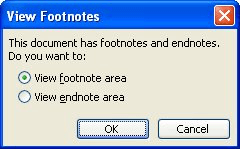Please Note: This article is written for users of the following Microsoft Word versions: 97, 2000, 2002, and 2003. If you are using a later version (Word 2007 or later), this tip may not work for you. For a version of this tip written specifically for later versions of Word, click here: Converting Individual Endnotes and Footnotes.
Written by Allen Wyatt (last updated September 5, 2020)
This tip applies to Word 97, 2000, 2002, and 2003
Word is flexible on whether a note is considered an endnote or a footnote. You can easily convert between the two, but the way you do the conversion is not necessarily intuitive. To convert from an endnote to a footnote (or vice versa), follow these steps:

Figure 1. The View Footnotes dialog box.
As you convert each endnote or footnote, it is moved to the other window and the reference marks for the note are updated to what is currently being used for the series (footnote or endnote) to which you are converting.
WordTips is your source for cost-effective Microsoft Word training. (Microsoft Word is the most popular word processing software in the world.) This tip (1884) applies to Microsoft Word 97, 2000, 2002, and 2003. You can find a version of this tip for the ribbon interface of Word (Word 2007 and later) here: Converting Individual Endnotes and Footnotes.

Discover the Power of Microsoft Office This beginner-friendly guide reveals the expert tips and strategies you need to skyrocket your productivity and use Office 365 like a pro. Mastering software like Word, Excel, and PowerPoint is essential to be more efficient and advance your career. Simple lessons guide you through every step, providing the knowledge you need to get started. Check out Microsoft Office 365 For Beginners today!
Text boxes and endnotes are both great tools you can use within a document. Problem is, you cannot use them ...
Discover MoreEndnotes can be placed in a couple of different places in your document, not just at the very end. Here's how you can ...
Discover MoreFootnote references normally appear as superscripted digits, both in the main body of your document and in the footnotes ...
Discover MoreFREE SERVICE: Get tips like this every week in WordTips, a free productivity newsletter. Enter your address and click "Subscribe."
There are currently no comments for this tip. (Be the first to leave your comment—just use the simple form above!)
Got a version of Word that uses the menu interface (Word 97, Word 2000, Word 2002, or Word 2003)? This site is for you! If you use a later version of Word, visit our WordTips site focusing on the ribbon interface.
Visit the WordTips channel on YouTube
FREE SERVICE: Get tips like this every week in WordTips, a free productivity newsletter. Enter your address and click "Subscribe."
Copyright © 2026 Sharon Parq Associates, Inc.
Comments